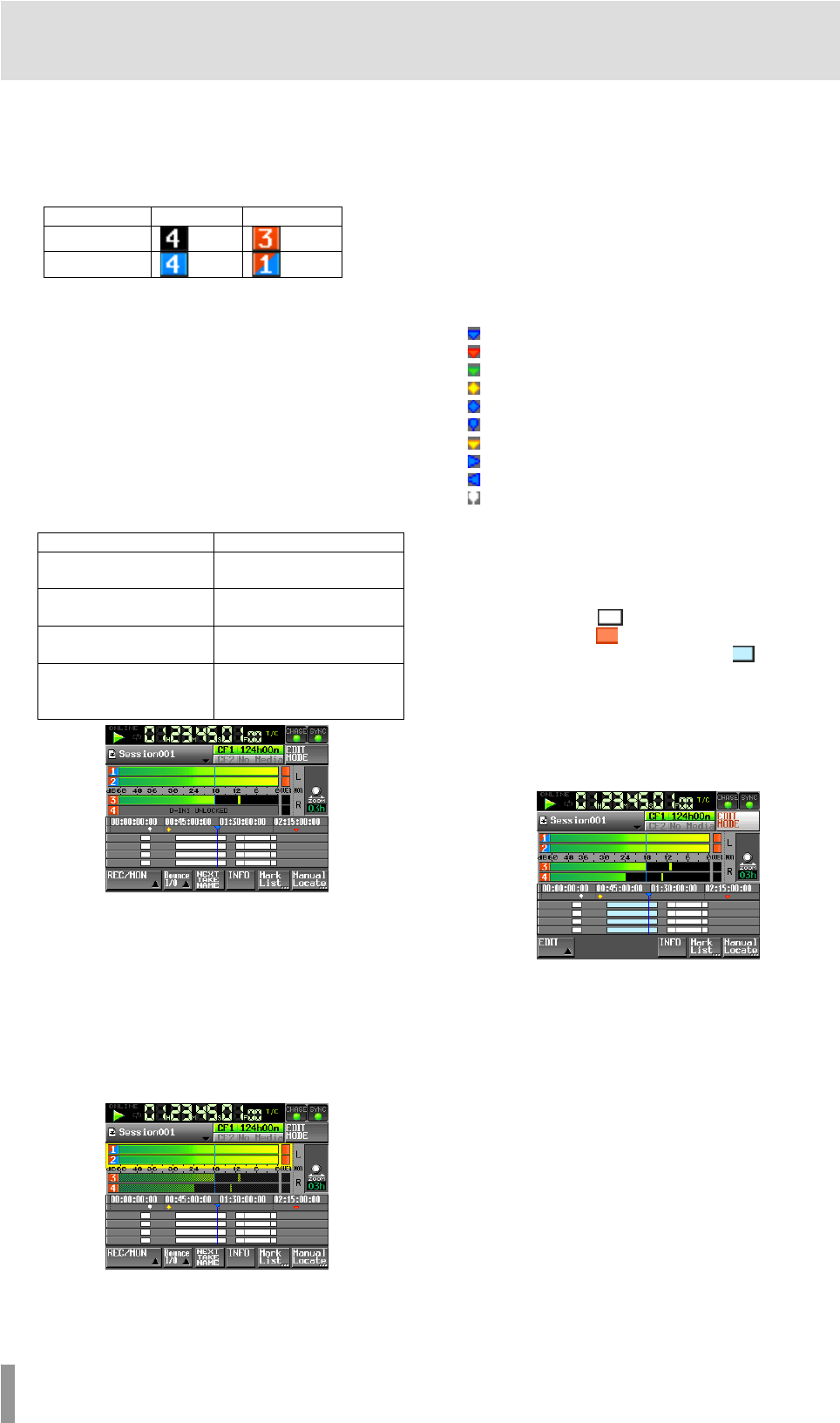
16 TASCAM HS-4000
2 − Names and functions of parts
9 Track numbers and record function and
input monitoring indicators
The indicators at the left end of the level meters show the
status of record arming and input monitoring. The
background colors of the indicators mean the following.
REC OFF REC ON
MON OFF
MON ON
10 Level meters
The input signal level for a track is shown if input monitoring
for it is set to ON or if it is armed for recording and not
playing back.
Each track also has an overload indicator at its right end that
appears red when the input overloads.
During playback, the playback level of a track is shown if
input monitoring is set to OFF.
When the input source is set to a digital input, but there is
no input signal or if the input signal differs from the internal
setting, the channel meter display area appears gray and
one of the following messages appears. (The “x” indicates
the channel.)
Display Meaning
D-INx NO SIGNAL
No input signal
D-INx UNLOCK
Input signal is not
synchronized with the system
D-INx NOT AUDIO
Cbit information of the input
signal is not audio
D-INx Cbit ERROR
Other input signal Cbit
information differs from the
actual operation mode
D–IN1 UNLOCK shown
The following settings can be made for the display of the
level meters on the
METER SETUP screen from the MENU
screen.
・ Metering point
・ Peak hold time
・ Release time
・ Overload indicator peak level
・ Reference level line display on/off
You can also touch these areas to output just one pair of
channels (1-2 or 3-4) for monitoring (solo function).
The level meters and track numbers for the soloed channels
appear highlighted in yellow. The level meters for the
channels that are not soloed appear shaded.
Touch the same channel pair again to stop soloing them.
11 Time display area
When the time display mode has been set to show a
timeline with four equal divisions, four times are shown.
This area has 4 equal divisions, showing 4 time points on the
timeline. The values match the time display mode.
12 Mark display area
Timeline marks appear here.
This area scrolls horizontally to correspond with the time
counter.
BC$CM mark
BC$END mark
BC$FILE mark
BC$PAUSE mark
BC$STANDBY mark
BC$START mark
BC$STOP mark
IN mark
OUT mark
Other types of marks
13 Track display area
The regions of tracks 1–4 (from top to bottom) are shown
here.
Region fade-ins, fade-outs and cross-fades are shown in
blue.
Normal areas: white
Being recorded: red
Fade-in, fade-out, cross-fade regions: blue
This area scrolls horizontally to correspond with the time
counter.
14 EDIT button
Touch this to turn ON/OFF the edit mode, which allows you
to divide, erase and cut parts of regions. (See “Editing
regions” on page 47.)
15 Recording media display (button)
This shows which of the CF card slots is being used and its
remaining recording time.
The background of the media that is currently being used
appears green during playback and red when recording.
If there is no media in the CF card slot,
No Media appears
on a light gray background.
If the CF card has no projects or sessions,
No Project
appears. When an unformatted CF card is inserted,
UNFORMAT appears.
When a CF card is inserted in the CF card slot that is not
being used during recording,
UNMOUNT appears. When
recording is stopped, the usual screen is shown.
If the total number of entries, including files and subfolders,
inside a session folder exceeds about 5000, recording
becomes impossible and
Rec Limit is shown. For details,
see “Recording operation limitations” on page 30.
